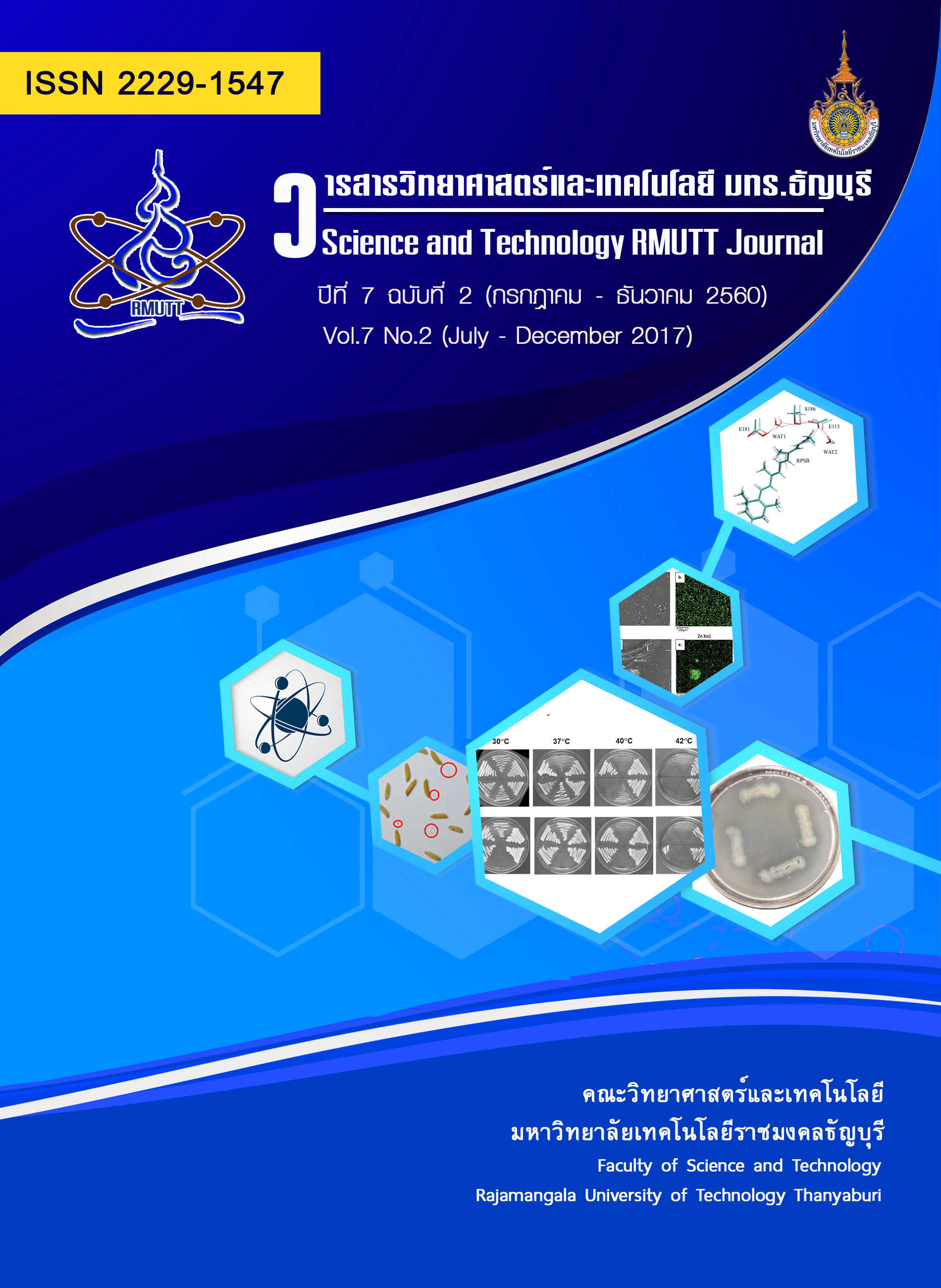Development of rice paper by using geminated Homnin brown rice flour
Main Article Content
Abstract
Health food is now being promoted among consumers due to its benefits such as reducing risk of non-communicable diseases. Germinated Homnin brown rice flour (GHNF) contains various health-promoting components such as dietary fiber, phytic acid, vitamins, gamma-aminobutyric acid (GABA), gamma-oryzanol and anthocyanin. Therefore, the objective of this study was to develop rice papers by using GHNF. Then, the effect of the ratio of GHNF:tapioca flour at 3 levels (45:55, 52:48 and 58:42) on the physical and chemical properties was determined, using rice papers made from rice flour as a reference. Moreover, sensory evaluation was conducted by 9-point hedonic scale. The results showed that water activity of all GHNF papers were in the range of 0.52-0.53. The tensile strength, cutting force and brittleness of 58% GHNF paper were not significantly different from the control (p≥0.05). The lightness (L*) were decreased while the redness (a*) was increased. However, the yellowness (b*) of all formulas were similar. The sensory evaluation indicated that the overall liking score of 58% GHNF paper obtained the highest score at 7.5 (like moderately to like very much). The chemical analysis found that the developed product had higher antioxidant activity and GABA content than control formula. Moreover, the GHNF rice papers showed medium glycemic index (GI). Therefore, this product was suitable for people who were health-exercising or the NCDs patients. Moreover, this can be an alternative option for adding value to the product and Thai rice.
Article Details
References
Pumipamorn, A. The report of flour production. Minitry of industry. 1990. 56-62.
Kunsaray, K. The chemical properties of seeds. Rice department, Minitry of agriculture and cooperatives. 1993. 54-70
Tuppra, U. Development of rice paper. Master degree thesis, Kasertsart University. 2001. 1-159.
Leardkamolkarn, V., Thongthep, W., Suttiarporn, P., Kongkachuichai, R., Wongpornchai, S. and Wanavijitr, A. Chemopreventive properties of the bran extracted from a newly-developed Thai rice: The Riceberry. Food Chemistry. 2011. 125 : 978-985.
Komatsuzaki, N., Tsukahara, K., Toyoshima, H., Suzuki, T., Shimizu, N. and Kimura, T. Effect of soaking and gaseous treatment on GABA content in germinated brown rice. Journal of Food Engineering. 2007. 78(2) : 556-560.
Ritthiruangdej, P., Parnbankled, S., Donchedee, S., & Wongsagonsup, R. Physical, chemical, textural and sensory properties of dried wheat noodles supplemented with unripe banana flour. Kasetsart J. (Nat. Sci.). 2011. 45 : 500-509.
Sirichokworrakit, S. Physical, textural and sensory properties of noodles supplemented with tilapia bone flour. International Journal of Biological, Veterinary, Agricultural and Food Engineering. 2014. 8(7) : 722-724.
Shen, Y., Jin, L., Xiao, P., Lu, P. and Bao, J.S. Total phenolic, flavonoids, antioxidant capacity in rice grain and their relations to grain color, size and weight. J Cereal Science. 2009. 49 : 106-111.
Ou, B., Huang, D., Hampsch-Woodill, M., Flanagan, J.A., Deemer, E.K. Analysis of antioxidant activities of common vegetables employing oxygen radical absorbance capacity (ORAC) and ferric reducing antioxidant power (FRAP) assays: a comparative study. Journal of Agricultural and Food Chemistry. 2002. 50 : 3122–3128.
Benzie, I.F. and Strain, J.J. The ferric reducing ability of plasma (FRAP) as a measuring of antioxidant power: The FRAP assay. Anal. Biochem. 1996. 239 : 70-76.
Tsukatani, T., Higuchi, T. and Matsumoto, K. Enzyme-based microtiter plate assay for γ-aminobutyric acid: application to the screening of γ -aminobutyric acid-producing lactic acid bacteria. Analytica Chimica Acta. 2005. 540 : 293-297.
Granfeldt, Y., Bjo¨rck, I., Eliasson, A.-C. An examination of the possibility of lowering the glycemic index of oat and barley flakes by minimal processing. The Journal of Nutrition. 2000. 130 : 2207–2214.
Kuntz and Lynn, A. Keeping Microorganism in Control. Food Product Design. 1992. 44-51.
Yodmanee, S., Karrila, T.T. and Pakdeechanuan, P. Physical, chemical and antioxidant properties of pigmented rice grown in southern thailand. Int Food Res J. 2011. 18(3) : 901-906.
Kovacs, M.I.P., Fu, B.X., Woods, S.M. and Khan, K. Thermal stability of wheat gluten protein: its effect on dough properties andnoodle texture. J. Cereal Sci. 2004. 39(1) : 9–19.
Cáceres, P. J., Villaluenga, C. M., Amigo, L. and Frias, J. Maximising the phytochemical content and antioxidant activity of Ecuadorian brown rice sprouts through optimal germination conditions. Food Chemistry. 2014. 152 : 404-414.
Ti, H., Zhang, R., Zhang, M., Li, Q., Wei, Z., Zhang, Y., Tang, X., Deng, Y., Liu, L. and Ma, Y. Dynamic changes in the free and bound phenolic compounds and antioxidant activity of brown rice at diffenrent germination stages. Food Chemistry. 2014. 161 : 337-344.
Barrett-Connor, E. and Orchard, T. Diabetes and heart disease. In: National Diabetes Data Group, Diabetes data Compiled. Washington, DC: US Dept of Health and Human Services, XVI-1-XVI-41. NIH publication no 85-1468. 1984.
Frost, G., Leeds, A., Trew, G., Margara, R. and Dornhorst, A. Insulin sensitivity in women at risk of coronary heart disease and the effect of a low glycemic diet. Metabolism. 1998. 47 : 1245-51.


